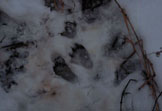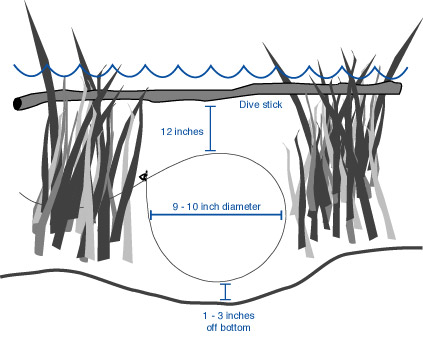Main Content
Article
River Otter Avoidance
Avoiding River Otter While Trapping
 There are a number of reasons a licensed trapper may want to avoid catching a river otter. They may have met their personal bag limit for river otters for the season, or the season may have closed early due to the statewide quota being met. Nuisance wildlife control operators may be trying to specifically target beaver at the request of citizen and want to avoid catching an otter. Below are some tips for avoiding catching a river otter in a trap.
There are a number of reasons a licensed trapper may want to avoid catching a river otter. They may have met their personal bag limit for river otters for the season, or the season may have closed early due to the statewide quota being met. Nuisance wildlife control operators may be trying to specifically target beaver at the request of citizen and want to avoid catching an otter. Below are some tips for avoiding catching a river otter in a trap.


Bounding Tracks, Hind Foot, Front Foot
Recognizing signs of otter
Otter inhabit any areas with water and food. If you are trying to avoid an otter, look for otter signs and place your traps elsewhere. Otter scat is usually greenish black, contains fish scales, and smells like musk mixed with fish. Otter often use latrines where scat is concentrated. You may notice a thick, yellowish deposit near latrines. Also, look for slides on steep banks. Otter slides are narrower than beaver slides but aren't common unless an area is heavily used by otter.
Lures
Use sweet lures for raccoon and castor lures for beaver. Avoid lures that contain fish oils, which will readily attract otter.
Trap placement
- Where you place a trap can greatly affect what type of animal is likely to be caught.
- Avoid putting sets near the dam crossover or near the inlet of the pond as these can be high use travel lane for river otter.

- Set where beaver leave a pond to search a food, as river otters may be less likely to use these spaces.
- Consider a castor mound on the edge of a pond, as castor isn’t as appealing to river otter.
- Avoid setting near abandoned beaver lodges and bank dens. These sets are not productive for beaver, and otter will readily use them.
- Make sets as close as possible to active lodges, as river otter may avoid areas of high beaver use.
- Be cautious with water edge sets for raccoons and instead place sets closer to raccoon feeding areas, such as a cornfields or woodlots.
- Avoid trails leading between waterways as these are high use travel lanes for river otters or use enclosed foothold traps (“dog-proof” traps) with sweet baits near these trails.
- When placing bodygrip traps or snares under water, place the trap near the bottom and place a large dry pole about 10 to 12 inches above the trap. Beaver tend to dive toward the bottom when they encounter a barrier, but otters are more likely to only make a shallow dive and will miss the trap.
Foothold
- Avoid using footholds on crossovers, which are high travel areas for otter.
- Castor mound sets with the trap set fairly deep are less likely to catch otter.
- If you do set beaver footholds near water edges, avoid putting them on submersion cables (“drowning wires”) so you have the opportunity to release any caught river otter using a sturdy catchpole or plywood board with a v notch in the bottom.
Underwater or stream-side snares
 On land (such as on a beaver slide or path), set your snare to a diameter of 9-10 inches with the loop 1 1/2 to 2 1/2 inches off the ground. This relatively large loop will typically snare beaver while passing otter will slide right through.
On land (such as on a beaver slide or path), set your snare to a diameter of 9-10 inches with the loop 1 1/2 to 2 1/2 inches off the ground. This relatively large loop will typically snare beaver while passing otter will slide right through. - Underwater use the same 9-10 inch diameter snare loop and add a stop that allows the loop diameter to close to not less than 6 inches. This will typically catch beaver but allow otter to slide through.
- Remember that it is only legal to use a snare on land owned by you or with written permission of a landowner.
- The maximum legal circumference (not diameter) for snare loops is 15 inches, unless at least half of the snare loop is covered by water or if the snare uses a relaxing snare lock.
Bodygrip traps
 Size 330 body-grip traps (Conibears) are one of the most commonly used beaver traps and river otter traps, but some minor modifications can help avoid catching river otter.
Size 330 body-grip traps (Conibears) are one of the most commonly used beaver traps and river otter traps, but some minor modifications can help avoid catching river otter.
- Move the trigger as far as you can to one side of the trap and bend the trigger wires close together.
- Shorten the trigger length to four to five inches by cutting or bending the wires, which allows the robust beaver to be caught by the slim otter to slide through.
- Put additional tension on the trigger. You can do this by purchasing a special tensioning trigger that allows you to closely control the release pressure, which means more force will be needed to trigger the trap. This can allow otters to swim through and brush the triggers without firing, but while close on beaver that exert more force.
- Another approach utilizes two triggers. The triggers are placed on each side of the trap. An animal swimming through the trap must strike both triggers in order for the trap to fire.
- Remember that Indiana regulations require that 330 body grip traps must be completely covered by water.
Raccoon sets
- Avoid 220 bodygrip trap blind sets along stream edges and cubby sets near waited baited with fishy baits.
- Enclosed foothold traps with sweet baits are a great alternative to bodygrips and footholds for raccoons and will avoid river otters.
- Avoid putting footholds set near water for raccoons on submersion cables (“drowning wires”) so you can release any river otters caught.
If you catch an otter . . .
If the river otter is alive and uninjured, safely release it using a sturdy catchpole or a piece of plywood with a v notch in the bottom if the otter is in a foothold. You can place the v notch over the otter’s leg with the foot in a trap on one side of the board where you are standing and the otter on the other, allowing to you to release the otter.
If the otter is dead, call your local Conservation Officer at 812-837-9536 to turn it in. There is no penalty for accidentally killing a river otter, but you are not allowed to take and possess the otter. Data will be collected from incidental otters to help inform management decisions.
